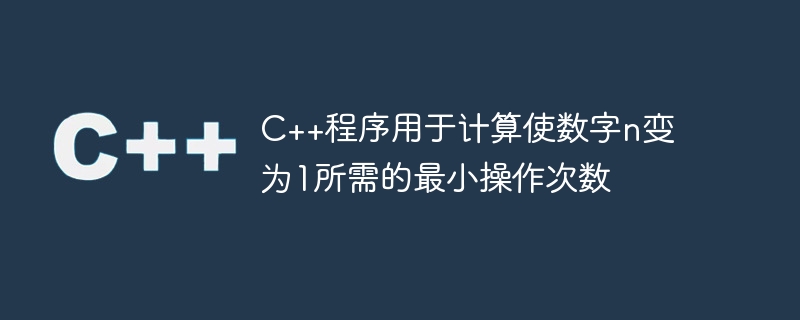 Backend Development
Backend Development
 C++
C++
 C++ program to calculate the minimum number of operations required to change a number n to 1
C++ program to calculate the minimum number of operations required to change a number n to 1
C++ program to calculate the minimum number of operations required to change a number n to 1
Sep 14, 2023 pm 10:53 PM
Suppose we have a number n. We arbitrarily perform one of these operations -
When n is divisible by 2, replace n with n/2
When n is divisible by 2 When n is divisible by 3, replace n with 2n/3
-
When n is divisible by 5, replace n with 4n/5
li>
We must calculate the minimum number of moves required for the number 1. If not possible, -1 is returned.
So if the input is something like n = 10, the output will be 4 because using n/2 we get 5, then we use 4n/5 to get 4, then n/2 again we get 2, and again n/2 Got 1.
StepsSteps h2>
To solve this problem we will follow the following steps-
m := 0
while n is not equal to 1, do:
if n mod 2 is same as 0, then:
n := n / 2
(increase m by 1)
otherwise when n mod 3 is same as 0, then:
n := n / 3
m := m + 2
otherwise when n mod 5 is same as 0, then:
n := n / 5
m := m + 3
Otherwise
m := -1
Come out from the loop
return mExample
Let’s see Following implementation for better understanding -
#include <bits/stdc++.h>
using namespace std;
int solve(int n) {
int m = 0;
while (n != 1) {
if (n % 2 == 0) {
n = n / 2;
m++;
}
else if (n % 3 == 0) {
n = n / 3;
m += 2;
}
else if (n % 5 == 0) {
n = n / 5;
m += 3;
}
else {
m = -1;
break;
}
}
return m;
}
int main() {
int n = 10;
cout << solve(n) << endl;
}input
10
output
4
The above is the detailed content of C++ program to calculate the minimum number of operations required to change a number n to 1. For more information, please follow other related articles on the PHP Chinese website!

Hot Article

Hot tools Tags

Hot Article

Hot Article Tags

Notepad++7.3.1
Easy-to-use and free code editor

SublimeText3 Chinese version
Chinese version, very easy to use

Zend Studio 13.0.1
Powerful PHP integrated development environment

Dreamweaver CS6
Visual web development tools

SublimeText3 Mac version
God-level code editing software (SublimeText3)

Hot Topics
 How to calculate addition, subtraction, multiplication and division in word document
Mar 19, 2024 pm 08:13 PM
How to calculate addition, subtraction, multiplication and division in word document
Mar 19, 2024 pm 08:13 PM
How to calculate addition, subtraction, multiplication and division in word document
 CUDA's universal matrix multiplication: from entry to proficiency!
Mar 25, 2024 pm 12:30 PM
CUDA's universal matrix multiplication: from entry to proficiency!
Mar 25, 2024 pm 12:30 PM
CUDA's universal matrix multiplication: from entry to proficiency!
 PyCharm usage tutorial: guide you in detail to run the operation
Feb 26, 2024 pm 05:51 PM
PyCharm usage tutorial: guide you in detail to run the operation
Feb 26, 2024 pm 05:51 PM
PyCharm usage tutorial: guide you in detail to run the operation
 Linux Deploy operation steps and precautions
Mar 14, 2024 pm 03:03 PM
Linux Deploy operation steps and precautions
Mar 14, 2024 pm 03:03 PM
Linux Deploy operation steps and precautions
 What to do if you forget to press F2 for win10 boot password
Feb 28, 2024 am 08:31 AM
What to do if you forget to press F2 for win10 boot password
Feb 28, 2024 am 08:31 AM
What to do if you forget to press F2 for win10 boot password
 Huawei Mate60 Pro screenshot operation steps sharing
Mar 23, 2024 am 11:15 AM
Huawei Mate60 Pro screenshot operation steps sharing
Mar 23, 2024 am 11:15 AM
Huawei Mate60 Pro screenshot operation steps sharing
 Discuz domain name modification operation guide
Mar 09, 2024 pm 04:36 PM
Discuz domain name modification operation guide
Mar 09, 2024 pm 04:36 PM
Discuz domain name modification operation guide
 PHP string manipulation: a practical way to effectively remove spaces
Mar 24, 2024 am 11:45 AM
PHP string manipulation: a practical way to effectively remove spaces
Mar 24, 2024 am 11:45 AM
PHP string manipulation: a practical way to effectively remove spaces






